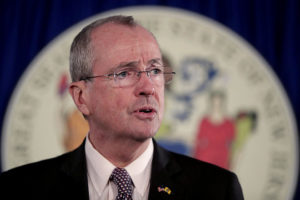April 30, 2021
Reading Time: 3 minutes
The New Jersey Chapter of the American Institute of Architects commends Governor Murphy for his commitment to climate change mitigation by releasing New Jersey’s first strategic plan for combating climate change. We offer our support to assist our state in reaching our collective goals. Architects are uniquely poised to help.
According to an announcement by Carly Sitrin, the New Jersey Department of Environmental Protection released a draft of the state’s first Climate Change Resilience Strategy, a plan intended to set state priorities for combating climate change.
Among its 100 recommendations, the Murphy administration is urging local governments and agencies to integrate climate change into local planning, regional transportation, housing and other infrastructure planning, as well as continuing to invest in renewable energy and launching a communications campaign to help New Jerseyans understand climate change.
“Confronting climate change requires decisive and intentional action across all sectors and levels of government. The Climate Change Resilience Strategy outlines a comprehensive set of actions designed to ensure that New Jersey’s communities and infrastructure are resilient against future storms and the impacts of climate change,” Gov. Phil Murphy said in a statement.
The introduction to the draft strategy makes clear that the plan is meant to be a framework with recommendations, not a prescriptive policy document, raising questions about how impactful the strategy will be. The strategy, released on Earth Day, identifies six state priorities, each of which includes recommendations the DEP said will guide state and local governments in their policymaking around climate change: Build resilient and healthy communities, strengthen the resilience of New Jersey’s ecosystems, promote coordinated governance, increase public understanding, expand resilience funding and protect New Jersey’s coastal zone.
Architects can lead the way with envelope improvements and other system efficiencies to get those emissions down. In a single year, architects tracking building energy use reduced their predicted carbon emissions by 17.8 million metric tons of CO2 per year. That’s like planting 21 million acres of forest.
Paule Melton and AIA Staff have shared that “The greenest building is one that’s already built,” according to Carl Elefante, FAIA, 2018 AIA President. Demolition and new construction both come with a big carbon footprint. Meanwhile, existing buildings often offer charms and amenities that cannot be achieved affordably with new construction. For buildings that are already in place, deep energy retrofits are a critical need that architects can help meet. “Retrofitting existing buildings to meet high-performance standards is the most effective strategy for reducing near- and mid-term carbon emissions,” says Elefante. These upgrades—especially when they leverage older buildings’ passive design strategies—have another benefit, too: improving resilience to hazards. Before deciding to invest in an existing building, first conduct a vulnerability assessment to ensure the building is not at high risk from wildfires, sea-level rise, or other climate impacts.
Architects have the opportunity to educate clients and builders on choosing carbon-smart materials. Manufacturing steel and concrete results in massive global warming impact. The carbon footprint represented by its materials is referred to as a building’s embodied carbon. Reducing embodied carbon over the next few years is a particularly important strategy because it will help us meet large-scale emission reduction targets recommended by global organizations. As discussed above, the simplest and most effective way to slash embodied carbon in the short-term is to choose an existing building.
To cut embodied carbon in new construction, we need to reduce our use of the highest-emitting materials like concrete, steel, aluminum, and foam insulation. We can get part of the way there by optimizing systems to ensure we aren’t specifying more material than is needed for the job. We can also choose alternatives like those recommended in Project Drawdown and Architecture 2030’s Carbon Smart Materials Palette.
After a building has achieved ultra-low energy consumption through smart design for building efficiency, it’s time to consider offsetting the rest of its energy use with renewables. When you bring up renewable energy, many people immediately think of solar panels, but they should take second priority to low-cost and no-cost efficiency and operational solutions. Start by talking to your clients about low-carbon energy procurement and green energy contracts. Understanding available renewables and how to efficiently use them in your buildings—that’s what’s ultimately needed to bring operational carbon to zero as envisioned by the 2030 Commitment.
While we won’t be able to fully reverse the impacts of climate change, we can guide our design teams and clients on climate-adaptive strategies. Whether updating an existing building or constructing a new one, Architects have several resources available to help create sustainable structures that will last for future generations including our resilience and adaptation education courses.
Architects can start projects with primers on building lifecycle assessments and energy modeling. Architects have a responsibility to advocate for sustainable design, which can be better for the environment, better for people, and beautiful at the same time. Recipients of the AIA COTE® Top Ten and AIA COTE® Top Ten for Students design awards exemplify how truly great architecture and sustainability go hand in hand. Together, we can create more inspiring buildings like these.
By Stacey Ruhle Kliesch, AIA, AIA NJ Advocacy Consultant | Posted in AIA-NJ News, Environment, Uncategorized | Tagged: #ArborDay, #EarthMonth, #NJClimateAction, GovernorMurphy | Comments (0)
Architects are creative professionals, educated, trained, and experienced in the art and science of building design, and licensed to practice architecture. Their designs respond to client needs, wants and vision, protect public safety, provide economic value, are innovative, inspire and contribute positively to the community and the environment.

414 Riverview Plaza, Trenton, NJ 08611
(609) 393-5690
info@aia-nj.org